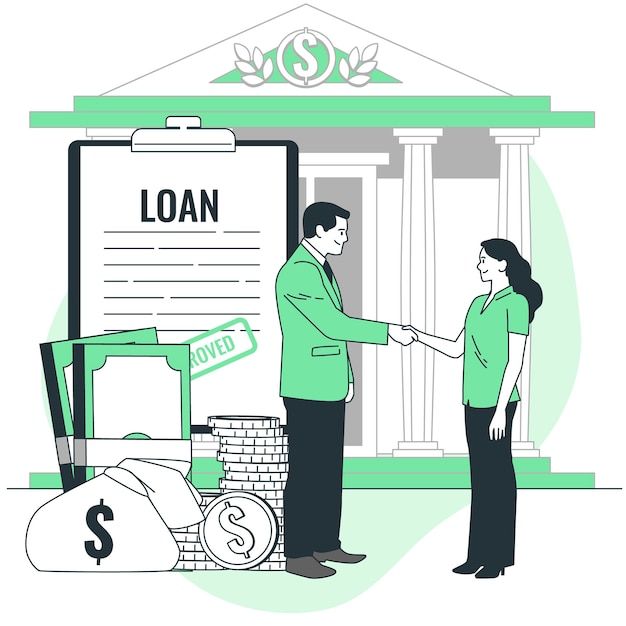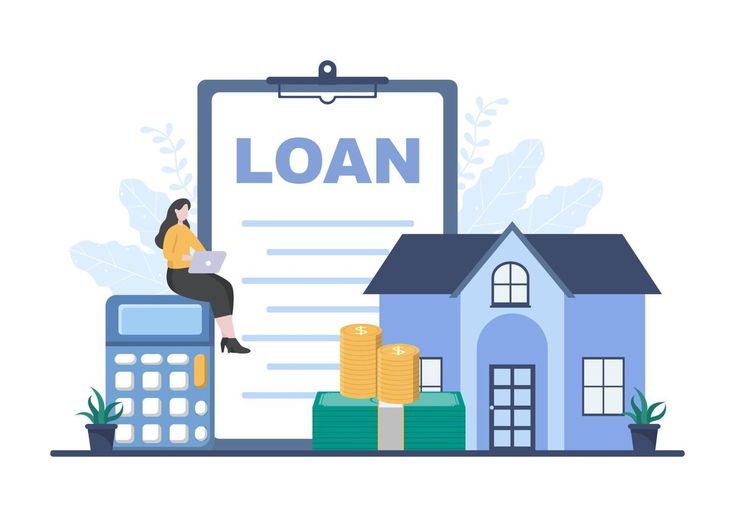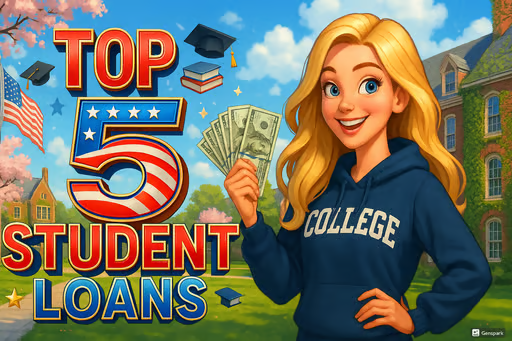Research suggests that with rising tuition costs averaging $10,680 for in-state public colleges and $38,330 for private institutions in 2025, selecting the right student loan can save borrowers thousands in interest while providing flexible repayment options.
Evidence from the Education Data Initiative indicates that the average student loan debt now stands at around $39,075 for federal borrowers, highlighting the need for informed choices to avoid long-term financial strain. Key considerations include interest rates, eligibility, and protections—federal loans often offer better safeguards like income-driven repayment, while private options may provide lower rates for those with strong credit.

𝐊𝐞𝐲 𝐏𝐨𝐢𝐧𝐭𝐬 𝐨𝐧 𝐂𝐡𝐨𝐨𝐬𝐢𝐧𝐠 𝐒𝐭𝐮𝐝𝐞𝐧𝐭 𝐋𝐨𝐚𝐧𝐬 𝐢𝐧 𝟐𝟎𝟐𝟓:
Prioritize Federal Loans First: They typically feature fixed rates starting at 6.39% for undergraduates, no credit checks for most, and benefits like interest subsidies and forgiveness programs, making them ideal for most students despite slightly higher rates than top private options.
Private Loans as a Supplement: For those needing more funding, lenders like Sallie Mae, College Ave, and Ascent offer variable rates as low as 4.24%-4.37%, but require good credit or a cosigner; they lack federal protections, so use them cautiously.
Potential Savings and Risks: Studies show borrowers can save $2,000-$7,000 over a loan’s life by choosing interest repayment options or adding a cosigner, but delinquency rates have risen to 11.3% for federal loans in 2025, underscoring the importance of manageable debt.
Controversy Around Private Lenders: While private loans fill gaps for about 13% of undergraduates, critics note higher default risks without federal forgiveness, though proponents argue they reward strong credit with competitive rates.
𝐔𝐧𝐝𝐞𝐫𝐬𝐭𝐚𝐧𝐝𝐢𝐧𝐠 𝐅𝐞𝐝𝐞𝐫𝐚𝐥 𝐯𝐬. 𝐏𝐫𝐢𝐯𝐚𝐭𝐞 𝐋𝐨𝐚𝐧𝐬.
Federal loans, backed by the U.S. Department of Education, provide borrower protections such as deferment during hardships and potential loan forgiveness after 10-25 years in public service or income-based plans. According to Bankrate, these make them preferable for most, especially amid economic uncertainty. Private loans from banks or lenders like Sallie Mae can offer lower rates (e.g., under 3% fixed for top applicants) and higher limits, but they often require credit checks and lack forgiveness options, per NerdWallet analyses.

𝐅𝐚𝐜𝐭𝐨𝐫𝐬 𝐭𝐨 𝐂𝐨𝐧𝐬𝐢𝐝𝐞𝐫 𝐁𝐞𝐟𝐨𝐫𝐞 𝐁𝐨𝐫𝐫𝐨𝐰𝐢𝐧𝐠.
Assess your financial need using tools like the FAFSA, which unlocked over $120 billion in aid in 2024. Compare rates via marketplaces like Credible, where private APRs range from 2.85% to 17.99%. Always exhaust grants, scholarships, and work-study first—data from the Federal Student Aid office shows nearly 30% of undergrads rely on subsidized loans, saving an average of $2,000-$4,500 in interest.
Tips for Smart Borrowing:
Apply early: Federal rates are fixed annually, with 2025-26 undergrad rates at 6.39%.
Use a cosigner: Boosts approval odds by 5x and lowers rates, as per Sallie Mae reports.
Monitor credit: Private lenders emphasize scores in the mid-600s or higher for best terms.
𝐍𝐚𝐯𝐢𝐠𝐚𝐭𝐢𝐧𝐠 𝐭𝐡𝐞 𝐁𝐞𝐬𝐭 𝐒𝐭𝐮𝐝𝐞𝐧𝐭 𝐋𝐨𝐚𝐧𝐬 𝐢𝐧 𝟐𝟎𝟐𝟓: 𝐈𝐧𝐬𝐢𝐠𝐡𝐭𝐬, 𝐃𝐚𝐭𝐚, 𝐚𝐧𝐝 𝐄𝐱𝐩𝐞𝐫𝐭 𝐑𝐞𝐜𝐨𝐦𝐦𝐞𝐧𝐝𝐚𝐭𝐢𝐨𝐧𝐬 𝐟𝐨𝐫 𝐑𝐞𝐝𝐮𝐜𝐢𝐧𝐠 𝐃𝐞𝐛𝐭 𝐁𝐮𝐫𝐝𝐞𝐧.
Paying for college remains a top financial hurdle in 2025, with tuition, books, and living expenses pushing the average cost of attendance to $27,000 for public four-year schools and over $55,000 for private ones, according to the College Board. But here’s the good news: Strategic borrowing can minimize your debt.
In this comprehensive guide, we’ll explore the top 5 student loan options based on current data from sources like the U.S. Department of Education, NerdWallet, and Bankrate. We’ll incorporate research-backed stats, pros/cons analyses, and real-world insights to help you choose wisely—potentially saving $5,000-$20,000 over your loan’s life.
Whether you’re an undergrad with financial need or a grad student seeking flexible terms, understanding these options is crucial. Did you know that 43.7 million Americans hold student debt totaling $1.75 trillion as of Q1 2025, per the Federal Reserve? Yet, smart choices like maxing federal aid first can reduce delinquency risks, which hit 11.3% for federal loans this year. Let’s break it down.
𝐖𝐡𝐲 𝐭𝐡𝐞 𝐑𝐢𝐠𝐡𝐭 𝐒𝐭𝐮𝐝𝐞𝐧𝐭 𝐋𝐨𝐚𝐧 𝐂𝐡𝐨𝐢𝐜𝐞 𝐢𝐬 𝐌𝐨𝐫𝐞 𝐂𝐫𝐢𝐭𝐢𝐜𝐚𝐥 𝐓𝐡𝐚𝐧 𝐄𝐯𝐞𝐫 𝐢𝐧 𝟐𝟎𝟐𝟓.
Many rush into the first available loan, but that’s risky. A 2025 TransUnion report shows student loan delinquencies rising modestly post-pandemic, with 30.6% of borrowers facing challenges by March—emphasizing the need for loans with built-in flexibility.
On the flip side, the right pick offers big wins:
- Cost Savings: Federal subsidized loans can save $2,000-$4,500 in interest versus unsubsidized, per Federal Student Aid data.
- Career Focus: Income-driven plans cap payments at 10%-20% of discretionary income, allowing grads to prioritize jobs over bills.
- Long-Term Impact: With average debt at $39,075 (Education Data Initiative), low-rate loans with rewards or no fees ease the burden.
Private loans now serve about 13% of undergrads at private schools (Earnest data), but federal options dominate for their protections. Always file the FAFSA— it distributed $120 billion in 2024, including grants that don’t require repayment.

𝐓𝐚𝐛𝐥𝐞: 𝐓𝐨𝐩 𝟓 𝐁𝐞𝐬𝐭 𝐒𝐭𝐮𝐝𝐞𝐧𝐭 𝐋𝐨𝐚𝐧𝐬 𝐢𝐧 𝟐𝟎𝟐𝟓 𝐎𝐯𝐞𝐫𝐯𝐢𝐞𝐰.
Detailed explanations for every loan are provided below the table.
| Rank | Loan Name | Interest Rate (Variable & Fixed) | Key Feature | Best For |
| 1 | Federal Direct Subsidized Loan | 6.39% fixed | Government pays interest in school | Undergrads with financial need |
| 2 | Federal Direct Unsubsidized Loan | 6.39% (undergrad), 7.94% (grad) fixed | No need-based eligibility | All undergrads and grads |
| 3 | Sallie Mae Smart Option Loan | 4.37%-16.99% variable; 2.89%-17.49% fixed | No fees, multiple repayment options | Students with cosigners needing extras |
| 4 | College Ave Undergraduate Loan | 4.24%-17.99% variable; 2.89%-17.99% fixed | Flexible terms up to 20 years | High-credit borrowers seeking simplicity |
| 5 | Ascent Student Loan | 4.34%-15.25% variable; 2.89%-15.61% fixed | No cosigner options available | Independent students or those building credit |
Rates effective as of August 2025; private rates include autopay discounts and vary by credit.
𝟏. 𝐅𝐞𝐝𝐞𝐫𝐚𝐥 𝐃𝐢𝐫𝐞𝐜𝐭 𝐒𝐮𝐛𝐬𝐢𝐝𝐢𝐳𝐞𝐝 𝐋𝐨𝐚𝐧 – 𝐓𝐡𝐞 𝐆𝐨𝐥𝐝 𝐒𝐭𝐚𝐧𝐝𝐚𝐫𝐝 𝐟𝐨𝐫 𝐀𝐟𝐟𝐨𝐫𝐝𝐚𝐛𝐥𝐞 𝐁𝐨𝐫𝐫𝐨𝐰𝐢𝐧𝐠.
Designed for undergrads demonstrating financial need via FAFSA, this government-backed loan is a top pick for minimizing costs.
Why does it stand out?
- The U.S. Department of Education covers interest while you’re in school at least half-time, during a 6-month grace period, and deferments—saving significant money.
- Fixed rate of 6.39% for 2025-26 disbursements (down from 6.53% last year, per CNBC).
- Borrowing limits: Up to $5,500/year for freshmen, $7,500 for juniors/seniors; aggregate $23,000.
- Repayment flexibility: Standard 10-year plan or income-driven options like SAVE, capping payments and offering forgiveness after 20-25 years.
Pros and Cons:
- Pros: No credit check; potential forgiveness via Public Service Loan Forgiveness (PSLF), which discharged $62 billion for 876,000 borrowers by 2025 (Federal Student Aid). Low delinquency risk due to protections.
- Cons: Limited to need-based undergrads; caps may not cover full costs for expensive schools.
Best For: Low- to middle-income undergrads. Nearly 30% of undergrads use these, saving $2,000-$4,500 in interest on average (Federal Student Aid Office data).
Research Insights: A 2025 Education Data Initiative study shows subsidized borrowers graduate with 15% less debt than those relying solely on private loans, thanks to interest subsidies.

𝟐. 𝐅𝐞𝐝𝐞𝐫𝐚𝐥 𝐃𝐢𝐫𝐞𝐜𝐭 𝐔𝐧𝐬𝐮𝐛𝐬𝐢𝐝𝐢𝐳𝐞𝐝 𝐋𝐨𝐚𝐧 – 𝐀𝐜𝐜𝐞𝐬𝐬𝐢𝐛𝐥𝐞 𝐟𝐨𝐫 𝐀𝐥𝐥 𝐒𝐭𝐮𝐝𝐞𝐧𝐭𝐬.
Available to undergrads and grads without proving need, this is a versatile federal option.
Why It Stands Out:
- Fixed rates: 6.39% undergrad, 7.94% grad for 2025-26.
- Higher limits: Up to $12,500/year undergrad (including subsidized), $20,500 grad; aggregate $57,500 undergrad, $138,500 grad.
- Same repayment perks as subsidized: Income-based plans, deferment, forbearance.
Pros and Cons:
- Pros: Easy qualification; covers gaps after scholarships. Over $38 billion borrowed by grads in 2023 (pre-2025 data, but trends hold per Institute for College Access & Success).
- Cons: Interest accrues immediately, adding to principal if unpaid.
Best For: Grads or non-need-based undergrads. About 46% of Direct Loan dollars went to grads in 2023-24 (Congressional Research Service).
Research Insights: NerdWallet notes federal loans’ edge in protections—private defaults are 2x higher without forgiveness options.
𝟑. 𝐒𝐚𝐥𝐥𝐢𝐞 𝐌𝐚𝐞 𝐒𝐦𝐚𝐫𝐭 𝐎𝐩𝐭𝐢𝐨𝐧 𝐋𝐨𝐚𝐧 – 𝐅𝐥𝐞𝐱𝐢𝐛𝐥𝐞 𝐏𝐫𝐢𝐯𝐚𝐭𝐞 𝐏𝐨𝐰𝐞𝐫𝐡𝐨𝐮𝐬𝐞.
A leading private lender, Sallie Mae shines for supplemental funding.
Why It Stands Out:
- tes: Variable 4.37%-16.99%, fixed 2.89%-17.49% (with autopay; as of Aug 2025).
- No origination/prepayment fees; three repayment options (deferred, $25 fixed, interest-only).
- Covers 100% of costs; cosigner release after 12 payments.
Pros and Cons:
Pros: 91% of undergrad loans cosigned in 2023-24, boosting approval 5x and cutting rates (Sallie Mae report). Save 17% on total cost with interest repayment.
Cons: Credit check required; variable rates can rise.
Best For: Students with cosigners who’ve maxed federal aid.
Research Insights: Sallie Mae’s 2024 report: Cosigners reduce rates significantly, saving $3,000-$7,000 over loan life.
𝟒. 𝐂𝐨𝐥𝐥𝐞𝐠𝐞 𝐀𝐯𝐞 𝐔𝐧𝐝𝐞𝐫𝐠𝐫𝐚𝐝𝐮𝐚𝐭𝐞 𝐋𝐨𝐚𝐧 – 𝐒𝐭𝐫𝐞𝐚𝐦𝐥𝐢𝐧𝐞𝐝 𝐚𝐧𝐝 𝐑𝐞𝐰𝐚𝐫𝐝-𝐅𝐨𝐜𝐮𝐬𝐞𝐝.
Replacing Discover (which ceased new loans in 2025), College Ave offers competitive terms.
Why It Stands Out:
- Rates: Variable 4.24%-17.99%, fixed 2.89%-17.99% (with autopay).
- No fees; terms 5-20 years; multi-year approval for simplicity.
- Cash back rewards for good grades in some programs.
Pros and Cons:
- Pros: Quick 3-minute app; high limits up to total cost. Ranked top by U.S. News for flexibility.
- Cons: Needs strong credit (mid-600s score); no federal protections.
Best For: High-achievers with a credit history.
Research Insights: LendEDU data: Similar reward programs returned millions to students in 2023, motivating performance.

𝟓. 𝐀𝐬𝐜𝐞𝐧𝐭 𝐒𝐭𝐮𝐝𝐞𝐧𝐭 𝐋𝐨𝐚𝐧 – 𝐈𝐝𝐞𝐚𝐥 𝐟𝐨𝐫 𝐈𝐧𝐝𝐞𝐩𝐞𝐧𝐝𝐞𝐧𝐭 𝐁𝐨𝐫𝐫𝐨𝐰𝐞𝐫𝐬.
Ascent excels with no-cosigner paths.
Why It Stands Out:
- Rates: Variable 4.34%-15.25%, fixed 2.89%-15.61% (with autopay).
- Rates: Variable 4.34%-15.25%, fixed 2.89%-15.61% (with autopay).
- Extras: Career coaching, 1% cash back graduation reward (avg. $365).
Pros and Cons:
Pros: No fees; 82% of borrowers improved credit scores (Ascent data). Over 115,000 served since 2018.
Cons: Higher rates for low-credit applicants.
Best For: Independents or internationals.
Research Insights: NerdWallet ranks Ascent top for no-cosigner options, filling gaps for 13% of private-school undergrads (Earnest).
𝐊𝐞𝐲 𝐓𝐚𝐤𝐞𝐚𝐰𝐚𝐲𝐬 𝐚𝐧𝐝 𝐅𝐢𝐧𝐚𝐥 𝐀𝐝𝐯𝐢𝐜𝐞.
Max federal loans for protections—private for extras. Compare via Credible or ELMSelect. With delinquency up, aim for debt under 1x expected salary (e.g., $60,000 post-grad). Consult advisors; borrow only what’s needed.

